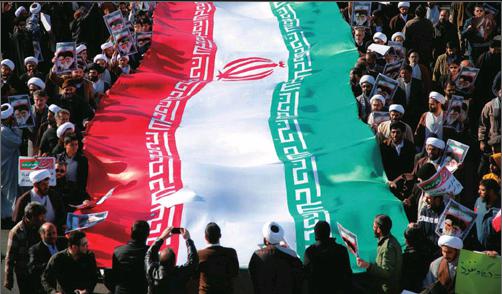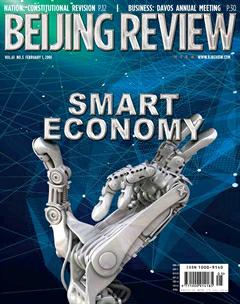Economic Issue or Political Game?
By+Lu+Jin

At the end of 2017, large-scale anti-govern- ment protests swept across Iran. Initially venting anger over the government raising prices in the second largest city Mashhad, the protests swiftly spread to several other cities across the country with the help of social media. Later, they assumed a political dimension, with a growing number of people calling on Irans supreme leader Ayatollah Ali Khamenei to step down. Irans intelligence department declared that “foreign agents” were involved in fomenting unrest, arresting a number of protesters.
After a week of violence, the protests were quelled and the situation was brought under control. Though the Islamic Revolutionary Guard Corps (IRGC) condemned foreign powers including the United States, Israel and Saudi Arabia for having instigated the protests, their origins are in reality less simple and more multifaceted.
Different fractions
When the fi rst crowd of demonstrators took to the streets of Mashhad to protest soaring prices and high inflation, Irans conservatives seized the opportunity to accuse President Hassan Rouhani of neglecting peoples livelihood and implementing budgetary and economic policies that had led to public dissatisfaction.
The reformists, for their part, believed that the protests were a conspiracy devised by conservative hardliners to weaken the Rouhani government. Mashhad is a city of Shia pilgrimage, often regarded as a conservative stronghold, with a usually sound city management and fiscal status due to abundant income from tourism. The protests broke out shortly after the government announced plans to stop arresting women for violating Islamic codes of dress, which antagonized conservative forces in Irans society and politics, with Rouhanis deputy Eshaq Jahangiri claiming that economic issues “were being used as an excuse and that something else, behind the curtain, is going on.” Many Western media outlets also asserted that conservative backstage manipulation was responsible for the crisis, with their ultimate purpose to pressure Khamenei to force Rouhani to step down.
With both conservatives and reformists capitalizing on the protests as a chance to bash the other, no action was taken to control the situation at fi rst, and the protests quickly spilled over to other cities while turning increasingly political in nature. Slogans at the demonstrations twisted against the government.
The main participants were young people aged 18 to 35. Among this group, sentiment toward the authorities is fraught. Many were born in the years after the IranIraq War and have mostly received a better education than their forebears. However, in a country which has for decades been stifl ed by U.S. sanctions, there is little space for these educated young people to fulfill their ambitions. Although the nuclear deal reached during Rouhanis fi rst term brought the promise of improved opportunity when it was signed two years ago, little tangible progress has actually been achieved since then. In the eyes of young Iranians, the conservatives with their vested interests care only for political stability rather than national development, and many are skeptical about their countrys governance and disillusioned about their own futures.endprint
Intrinsic issues
Iran is an Islamic republic. Its political system is characterized by the pairing of a secular regime with an Islamic theocratic system. In reality, Irans theocratic establishment, under the control of the conservatives, usually holds more power than the elected government. In vying for power, Irans two camps, the conservatives and the reformists, often make accusations and defame each other in order to win public support, particularly during general elections.
However, in recent years, the Iranian public has become increasingly dissatisfied with the authorities, with corruption, elite privileges, environmental pollution, defi ciency of water resources, rising ethnic problems and the adversity of life under U.S. sanctions all contributing to general discontent. People have begun to doubt the governments domestic and foreign policies, attributing the countrys problems to the current political system.
During the most recent general election last May, voters were not satisfied with the moderate Rouhani administration, but even so they displayed greater reluctance at the prospect of revolution, which has brought upon other countries war and chaos. A lack of an appealing alternative is essentially the reason Rouhani secured his second term.
Through joining hands with Rouhani, Irans reformists have dominated in national governance and have been trying to bring about economic reform. If Rouhani can successfully implement economic reform in his second term, it is likely he will also secure a reformist victory at the next general election. After securing his position, Rouhani attempted to challenge the current regime by stressing his own legitimacy, stating that his mandate to rule came from 24 million voters. His words aroused fierce criticism from the conservative camp, with Khamenei himself warning Rouhani that if he cannot prevent polarization between his supporters and opponents, he risks having to leave offi ce.
Rouhanis attempt to speed up economic reform has also been met with considerable domestic resistance. He put forward an industry development initiative to promote economic growth, increase employment, reform the financial system and improve conditions in order to attract more foreign investment, as well as speeding up privatization to increase the private sectors role in economic development. He also spoke out about the way that the IRGCs economic privileges have hindered the development of Irans private economy. Nonetheless, Rouhanis blueprint for reform was boycotted by the conservatives, and this lack of accomplishment has left many of his young supporters feeling let down.endprint
The roots of the recent protests lie in the intensification of political infighting. Given the current state of polarization, many observers are concerned over future political gaming concerning the succession of the countrys supreme leader, which promises to be even more consequential.
Way forward
There have been several major social movements in the history of the Islamic Republic of Iran, during which the countrys ruling elites have always been able to maintain social and political stability. The latest protests nonetheless caused concern to Irans authorities. During the protests, the Rouhani administration maintained a cautious and rational attitude toward the demonstrators, and acknowledged peoples right to protest and criticize the government. The IRGC also practiced restraint in quelling the unrest in order to avoid providing the United States with a pretext to abandon the nuclear deal.
To improve the domestic situation, it is urgent for Iran to carry out systematic reform in both politics and the economy in order to allay the political infi ghting that has produced such disenchantment among the Iranian people. Foreign strategies must also be adjusted, with a greater focus on internal economic development. In an era of pervasive globalization, Irans younger generations are more concerned with employment prospects and higher incomes than Islamic idealism, and a failure to acknowledge this will heighten the potential factors for social unrest. Even Irans old enemy, the deeply conservative Saudi Arabia, has started comprehensive social reform to this effect.
At present, the Rouhani administration is facing several serious challenges. The United States will continue to impose sanctions on Iran, particularly targeting the conservatism of the IRGC. It is also likely that the United States, Israel and Saudi Arabia will continue to jointly contain all Iranian efforts to expand its influence. In light of these pressures, the IRGC still assumes an important task of protecting the countrys national security in order to protect its economic development. So long as these conditions persist, it is wrong for the Rouhani government to completely break the military organizations monopoly over Irans economy. Rouhani is thus left with two choices. He can either persuade Khamenei to issue orders that limit the IRGCs economic activities, or the Rouhani administration itself can make use of the IRGCs capital advantage to achieve rapid economic development and job creation, although the latter would contradict the original intention of his reforms.
The recent instability has had a negative impact on Irans investment environment. Under pressure from U.S. sanctions, Western enterprises will be more cautious about investing in Iran. The Rouhani administration must then be more active in responding to the demands of the youth and the jobless in order to avoid a widening of the social divide. It must also continue strengthening relations with European nations, as well as increasing economic and security cooperation with China and Russia, avoiding any potential confl ict with the United States.endprint

